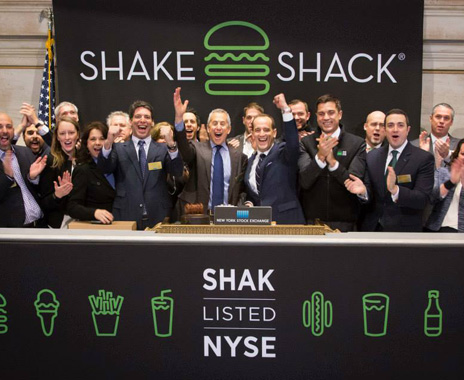My annual tradition of regaling you with the biggest brand stories of the year in fast food continues. The news items from 2015 run quite the gamut, from an eye-popping IPO to a highly anticipated leadership change to some misguided advertising choices and more.
Shake Shack went public and investors went crazy. Shake Shack started the year off with a bang. The popular burger chain doubled its stock value in its first day of trading as a public company, closing at $45.90. The IPO topped that of Habit Burger and Zoës Kitchen, two brands that attracted significant investor interest last year. Defying critics who claimed the company was extremely overvalued and not worth the hype, Shake Shack turned in 12.9 percent same-store sales results and a 75 percent gain in total revenue in its Q2 2015 report, and it also posted a very favorable full-year outlook. The burger chain’s continued success can be attributed to limited-time-offer partnerships with chefs, store openings in new markets with pent-up demand, and tests of new products like its Chicken Shack chicken sandwich.
McDonald’s got a new chief. McDonald’s start to the year was equally significant—25-year veteran Don Thompson abruptly retired after he had served less than three years as president and CEO, and the company appointed Steve Easterbrook to the helm. Easterbrook, also a company long-timer, took the reins of McDonald’s after 2014 sales dropped by 2 percent and earnings fell 15 percent. While the results have been a mixed bag, there are some signs of progress; along with earning hype with the October rollout of all-day breakfast, McDonald’s finally saw positive sales growth in the third quarter, posting a 0.9 percent increase in the U.S.
Starbucks struck a nerve. When Starbucks CEO Howard Schultz initiated the company’s “Race Together” campaign in March, he intended to stimulate conversation about the racial tensions that had been characterizing the nation’s landscape. But many customers and influencers pushed back at baristas writing “Race Together” on coffee cups and inviting dialogue on such a divisive topic, so the company backed off the in-store aspect of the initiative. Instead, it pressed on with open forums for employees, special sections in USA Today, a commitment to hire 10,000 “opportunity” youth, and expansion into urban communities. It’s unlikely that the “Race Together” incident will deter Starbucks from engaging in future efforts that extend beyond running restaurants, since Schultz has made it clear he believes corporations must try to make a positive social impact.
KFC introduced two new-ish advertising characters. In May, KFC launched ads featuring former Saturday Night Live comedian Darrell Hammond playing Colonel Sanders. The spots were derided as creepy, distasteful, and just plain weird, but a new Colonel was still introduced three months later, all according to plan. This time, in a twisted, confusing, and distracting storyline, the character, played by another SNL alum, Norm Macdonald, claimed that Hammond had been an impostor in the old spots. Importantly, neither stunt has managed to help the brand regain ground lost in the U.S. to rivals.
Subway suffered two blows. Things had already been looking pretty dim for Subway this year. Its fall from second-largest restaurant chain to No. 3 in the QSR 50 had been based off an estimated annual sales decline of 3.3 percent. Then, over the summer, federal investigators raided the home of longtime pitchman Jared Fogle. Fogle ended up pleading guilty to possession of child pornography charges, and Subway cut ties with him. Since Subway’s advertising had become less reliant on Fogle in recent years, the damage done by this incident may not be as bad as it could have been.
But then the chain’s gregarious and hands-on cofounder and CEO Fred DeLuca passed away in September after suffering from leukemia. DeLuca’s sister, Suzanne Greco, had been appointed as company president to run the day-to-day operations during his illness, and at the time I’m writing this, it’s unclear whether or not she will rise to the chief executive post. But most everyone would agree DeLuca was the brand’s heart and soul, and the chain will need another strong, aggressive leader if it hopes to stem its losses.
Taco Bell closes one new concept and opens another. In last year’s round-up, I wrote about U.S. Taco Co., Taco Bell’s foray into the fast-casual segment. Serving a simple lineup of premium tacos, fries, and shakes, the concept was considered the company’s response to Chipotle. But, after struggling to generate enough foot traffic and experiencing difficulties securing alcohol permits, Taco Bell decided to shutter it this year.
The company explained the move would allow it to focus on a new concept targeted at the urban Millennial consumer: Taco Bell Cantina. It now operates two Cantina locations, one in Chicago and another in San Francisco. The new concept serves alcoholic beverages and mix-ins, as well as appetizer-style items for sharing, and it features an open kitchen, a mobile-ordering pick-up window, and a lot of digital screens. It remains to be seen whether Taco Bell Cantina will expand as a separate concept or be used primarily as a testing ground for innovations to be introduced into all Taco Bells. Either way, the brand has clearly put a priority on wooing Millennial customers with more and more innovations.
As this is my last Brand New Perspectives column for QSR, I want to say a heartfelt thank you for your readership these past five years. I’ve enjoyed hearing from many of you and sharing perspectives on this industry that we all love so much. Please stay in touch: My Twitter handle is @deniseleeyohn.





